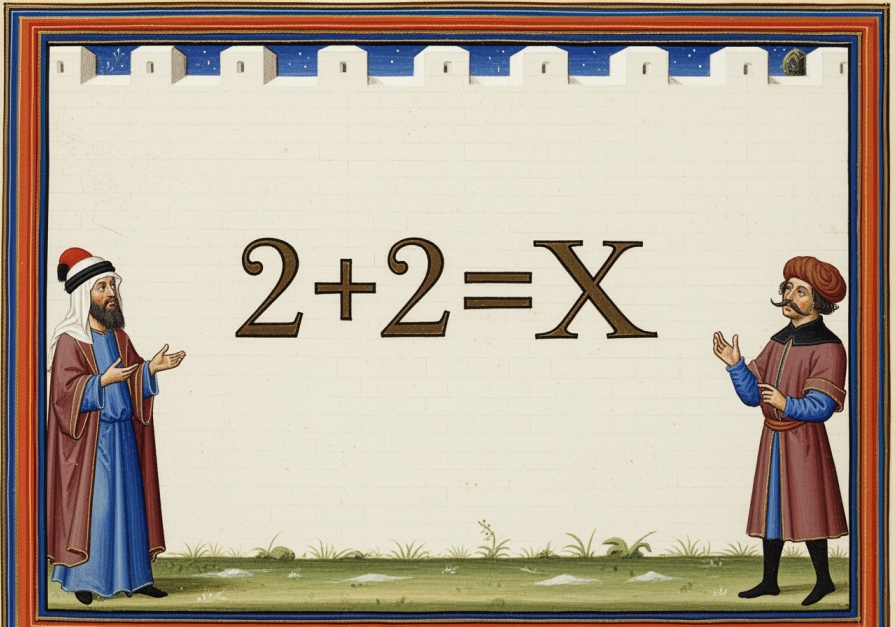Many of you probably haven't even thought about why the letter X is so firmly attached to the unknown in equations. Since childhood, this Latin letter accompanies everyone in math lessons: first in simple problems like "5 + X = 8", and then in more complex formulas. It seems that this has always been the case, but in fact, the history of this symbol is quite curious, and X's path to school notebooks turned out to be long and confusing.

How Mathematics Did Without X
Once upon a time, at the dawn of science, people did not even think of denoting numbers or unknowns with letters. Everything that had to do with calculations was considered part of geometry. Ancient scientists mainly relied on figures, lengths, areas and volumes. Problems were solved with the help of segments and areas, and this system was quite satisfactory for everyone, as long as the tasks remained simple.
But as soon as mathematicians were faced with the need to solve more abstract problems, the approach began to stall. Then the first step towards algebra in the modern sense appeared. It was made by the ancient Greek scientist Diophantus of Alexandria: he refused to be tied to geometric objects and began to use symbols. Interestingly, he marked the unknown in his calculations not with an X at all, but with a special sign resembling the Greek sigma at the end of a word — this move allowed him to describe problems much more flexibly.

What Happened Next: The Arab East and New Ideas
While Europe was sinking into the darkness of the Middle Ages after the fall of the Roman Empire, science continued to develop in the East. The Persian mathematician Al-Khwarizmi systematized knowledge of arithmetic, relying on the decimal system; It was his work, which dealt with "completion and contrast", that became the basis for the term "algebra" itself.
Oriental scientists used words in their works, not symbols, they could solve problems not only with specific examples, but also formulate a general rule. However, there were no letter designations in their notes, everything was explained in words.
How Algebra Came to Europe
Over time, the works of Oriental scholars began to penetrate into Europe, especially through Spain, where Arabic culture left a noticeable mark.
Symbols also began to appear: first plus and minus signs, a little later - an equal sign and a decimal point. At this stage, the French mathematician François Viète stood out, proposing the first use of letters to denote variables.
True, his system was quite complex: he denoted known meanings with consonants, and unknown meanings with vowels. While this method helped formalize the calculations, it remained inconvenient in a practical sense.

René Descartes and the Modern Mathematical Language
The real breakthrough happened in the XVII century thanks to the French philosopher and mathematician René Descartes. In his work "Geometry", he introduced a notation system that we still use today. Descartes proposed to use the letters a, b, c, and so on from the beginning of the Latin alphabet for known meanings, and letters from the end for unknown ones: x, y, z.
Why he chose these letters is a separate question. There are two versions here. According to one of them, everything is explained by the personal preferences of Descartes himself - he just wanted to, and when a person at his level of authority introduces something into scientific use, it is quickly picked up by followers.
But the second version seems much more interesting!
And what about X really?
It turned out to be a matter of the peculiarities of the translation. In many Arabic mathematical treatises, the unknown was denoted by the word "shai", which means "thing" or "something indefinite". But when these works were translated into Spanish, a problem arose: the Spanish alphabet simply did not have the sound "sh", and it was necessary to convey the Arabic word exactly.
A rather original solution was found: to use the Greek letter χ (chi). Later, when the texts were translated from Spanish into Latin, this letter was replaced by the Latin X, because visually they are similar, and the Latin alphabet was more understandable to European scientists.
Thus, through translation difficulties, geographical intersections, and the authority of great mathematicians, X became the very letter that you are used to seeing in equations. It was along this chain that our good old unknown came from the Arabic "shai" through the Greek χ and the Latin X to mathematics!

Total
It turns out that the history of the appearance of X in algebra is not a whim of one person or an accidental coincidence, but the result of a long journey: from ancient problems with segments, through Arabic treatises, complex translations and reforms of the mathematical language in Europe. All this eventually formed a system of notation familiar to everyone, where the unknown is almost always X.
So the next time you write down the usual "3X + 5 = 11", it is worth remembering that there is a whole history of several thousand years behind this letter!













